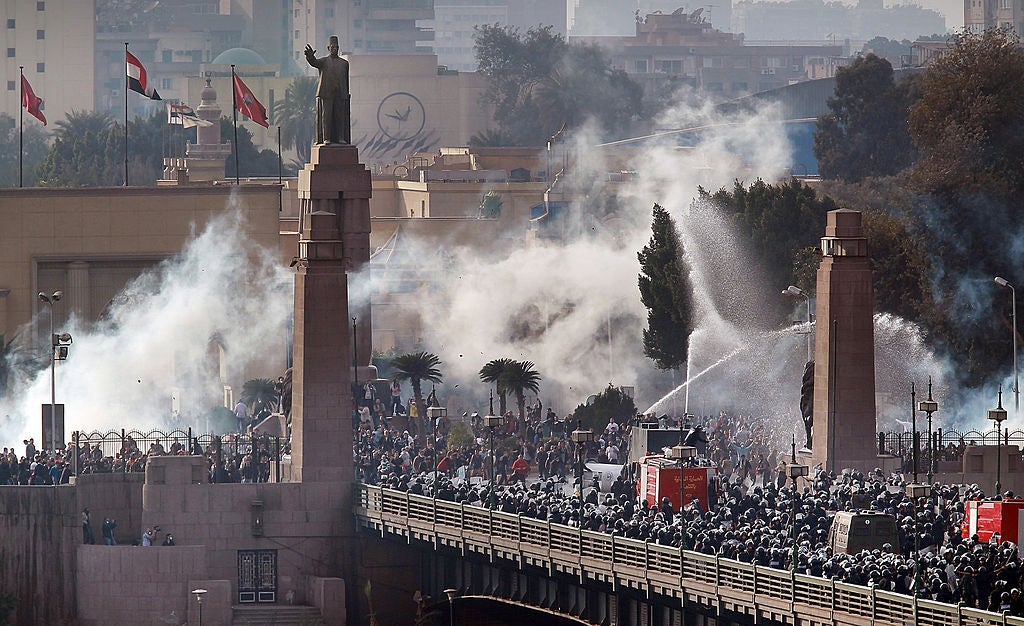Ten years on from the uprising in Tahrir Square, Egyptians’ hopes of reform are in tatters
The country’s ruler for the last eight years, Abdel-Fattah el-Sisi, has turned Egypt into a police state more repressive than it ever was under Hosni Mubarak or Anwar Sadat, writes Borzou Daragahi


It was a decade ago when thousands of mostly young Egyptians flooded the streets of central Cairo on National Police Day, 25 January, and sought to change the course of their nation.
They were inspired by the revolution that had toppled Tunisia’s ruler, Zine el Abidine Ben Ali, 11 days earlier and enraged by the police killing of a young man in Alexandria the previous year, a tragedy compounded by the humiliating, sham parliamentary election in late 2010 that had solidified President Hosni Mubarak’s hold on power.
Despite a brutal response by Mubarak’s security forces, the movement caught fire, drawing in young supporters eager for change, as well as the country’s main opposition, the Muslim Brotherhood, which helped crowds push their way past riot police on the Qasr El Nil bridge and into the capital’s iconic Tahrir Square, chanting, “The people want the fall of the regime!”
For days, the protesters held the square, beating back incursions by the regime’s thugs, the baltagiya, who stormed the crowd with all manner of weapons and even on camels, killing hundreds of unarmed civilians. The protesters of the square captured the imagination of the world, and on 11 February 2011, they won – or so it seemed – with Mubarak resigning.
But from that moment of joy, Egypt’s trajectory descended steadily into chaos, dictatorship and despair. Mubarak’s opposition all despised him, but could agree on little else. The powerful armed forces, which remained the country’s most resilient and conservative institution, manipulated social and political divisions to retain its clout, ultimately crushing Egyptians’ democratic aspirations.
The country’s ruler for the last eight years, former army officer and intelligence chief Abdel-Fattah el-Sisi, has turned the country into a police state more repressive than it ever was under either Mubarak or Anwar Sadat, who ruled Egypt during the 1970s.
Human Rights Watch’s 2021 World Report described the country as being “under the harsh authoritarian grip” of Sisi and his cronies in the security establishment. Thousands of dissidents, journalists, human rights activists rot in dank prisons, some held without formal charges. Any sign of dissent is quickly crushed. Even famously fun-loving Egyptians celebrating their sexuality on social media are punished for violating Sisi’s staid sense of morality.
“To me the worst part of Sisi’s rule is that the balance between coercion and consent is different even from Mubarak or Sadat – it’s much more coercion,” says Michelle Dunne, a former American diplomat who served in Egypt and is now a researcher at the Carnegie Endowment for International Peace.
“Egyptians surmounted the wall of fear between them and the state,” she says. “Sisi has had to use an astonishing level of brutality to build that wall back up. That’s the saddest part – just the level of brutality, human rights abuses, political oppression, the crushing of state institutions that once had some integrity.”
Along with Sisi’s brutality is a megalomaniacal vision for Egypt that is light on improving the lives of ordinary Egyptians but heavy on expensive, big-ticket projects that appear to be opportunities for Sisi and his allies to raid the public treasury. They include the multibillion-dollar expansion of the Suez Canal and the construction of a “New Cairo” in the desert to the capital’s east. Next up is a $32m “Cairo Eye”, which is being pitched as Africa’s largest ferris wheel in an attempt to draw tourists to see the smog-choked capital.
Sisi’s projects are pricey, environmentally questionable, and arguably unnecessary in a country where many poor people lack access to clean water and proper sanitation, and even the middle classes complain of decrepit health and education services.
But bloating Sisi’s sense of impunity is the rest of the world, which mostly turns a blind eye to his abuses and waste. He remains in the excellent graces of the world’s powers, who continue to sell the country more advanced weaponry than it needs. Dunne notes that Sisi has spent on weapons from the US, Russia, France and other countries about the same amount he has borrowed against the country’s future from the International Monetary Fund to deal with the fallout of the coronavirus pandemic.
Incredibly, despite the tremendous risks, Egyptians still take to the streets to protest corruption, police brutality and declining living standards, most recently in October, but also throughout 2019.
Hopes for any kind of gradual reform have been dashed. Sisi has excluded all but the most sycophantic supporters and bootlicking loyalists from the country’s decision making. Not just the Islamists whom he has hunted down, jailed, tortured and executed, but also liberals, leftists and even nationalists scornful of his authoritarian ways are cut out, silenced and jailed. The coalition of disparate political and social forces that came together to topple the regime of Mubarak 10 years ago remain as mistrustful of each other as they are fearful of the regime.
Perhaps the biggest lesson of 25 January 2011 is that those seeking to topple a dictatorship should sketch out what they want and how they would work together before they hit the streets. “They knew what they wanted: to bring Mubarak down,” says Dunne. “They didn’t know what they wanted instead.”
Join our commenting forum
Join thought-provoking conversations, follow other Independent readers and see their replies
Comments


Bookmark popover
Removed from bookmarks